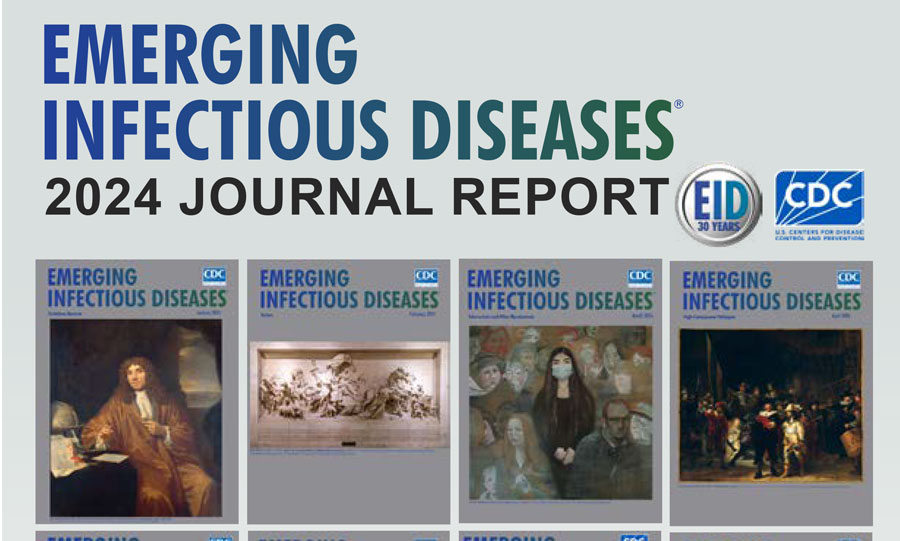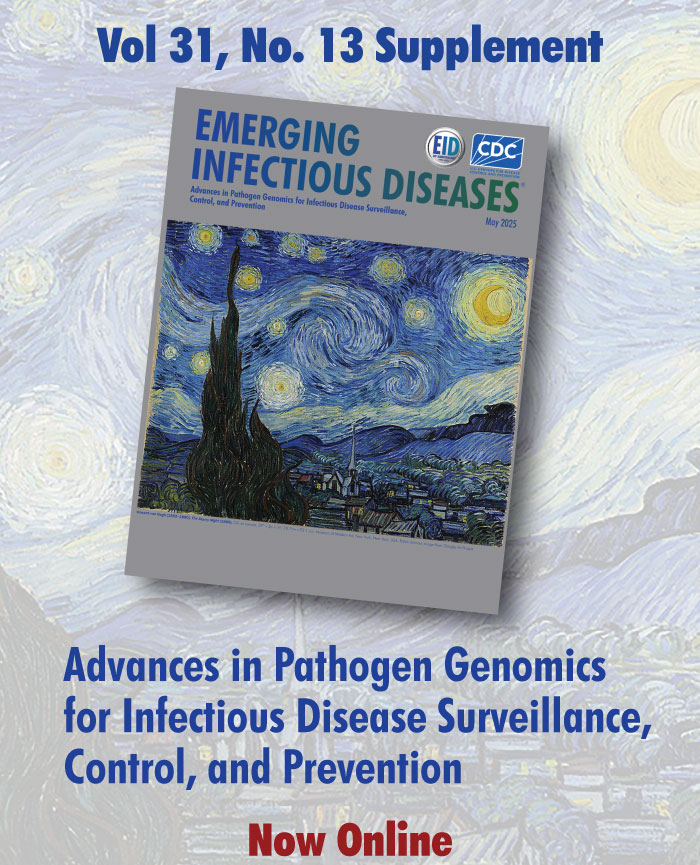Early Release
Disclaimer: Early release articles are not considered as final versions. Any changes will be reflected in the online version in the month the article is officially released.
Volume 31, Supplement—October 2025
Supplement
- Long-Term Illness in Adults Hospitalized for Respiratory Syncytial Virus Disease, United States, February 2022–September 2023
-
Nonspecific Symptoms Attributable to Lyme Disease in High-Incidence Areas, United States, 2017–2021
For some patients who have Lyme disease (LD), nonspecific symptoms can persist after treatment and impair quality of life. Estimating the frequency and duration of such symptoms is challenging. Using commercial insurance claims data from 2017–2021 for enrollees residing in states where LD is common, we identified 24,503 case-patients with LD and matched them (1:5) with 122,095 control-patients with other diagnoses by demographics, medical service date, and inpatient/outpatient setting. We compared relative frequencies of diagnosis codes for pain, fatigue, and cognitive difficulties between case-patients and control-patients in the year after diagnosis. Those symptom codes occurred 5.0% more frequently among case-patients than among control-patients and comprised »11.0% of the total symptom codes among case-patients. Symptom code frequency among case-patients declined significantly in the 6–12 months after LD diagnosis and reached levels similar to control-patients by the end of the year, with the exception of fatigue.
- Progress Toward Understanding Infection-Associated Chronic Conditions and Illnesses
-
Persistence of Symptoms among Commercially Insured Patients with Coccidioidomycosis, United States, 2017–2023
Some patients with coccidioidomycosis experience prolonged respiratory and systemic symptoms. However, data on prevalence and persistence of most symptoms are lacking. Using an insurance claims database, we identified patients with coccidioidomycosis diagnoses in the United States during 2017–2023. We assessed prevalence of associated symptoms from 6 months before to 1 year after first diagnosis code (index date) and compared post–index date prevalence to baseline (within 6 to 4 months before index date). Among 2,640 patients, cough (20.8%), dyspnea (13.0%), and fatigue (8.8%) were the most common symptoms at index date. Dyspnea and erythema nodosum were elevated 3–6 months post–index date (p<0.03), and fatigue, headache, joint pain, and weakness were elevated 9–12 months post–index date compared with baseline (p<0.05).These findings demonstrate that symptoms can persist in coccidioidomycosis patients, which could help inform clinical management and refine estimates of the health and economic burden of coccidioidomycosis.
Volume 31, Number 11—November 2025
Synopses
- Haematospirillum jordaniae Infections after Recreational Exposure to River Water, Pennsylvania, USA, 2020
-
Trichosporon austroamericanum Infections among Hospitalized Patients, France, 2022–2024
During 2022–2024, six cases of invasive fungal infection occurred among immunocompromised patients at Marseille University Hospital, Marseille, France. Matrix-assisted laser desorption/ionization time-of-flight mass spectrometry initially identified Trichosporon inkin fungi. However, phylogenetic analysis of intergenic spacer region 1 and whole-genome sequences revealed the genetically distinct species T. austroamericanum. Analysis of core genome and mitogenome from 6 patient isolates and 1 environmental isolate revealed substantial genetic diversity among T. austroamericanum strains, indicating a polyclonal outbreak. Furthermore, the mitochondrial genome emerged as a potential marker for intraspecies differentiation, which potentially could aid in epidemiologic investigations. Identified in 2024 but potentially underestimated, T. austroamericanum has since been reported in case clusters from hospital settings in France, highlighting the need for accurate fungal identification and suggesting previously identified T. inkin cases should be re-evaluated for T. austroamericanum. Clinical T. austroamericanum is emerging in hospital settings and should be included in the differential diagnosis of fungal infections.
Research
-
Two Independent Acquisitions of Multidrug Resistance Gene lsaC in Streptococcus pneumoniae Serotype 20 Multilocus Sequence Type 1257
Among >25,000 invasive pneumococcal disease isolates recovered in US locations during 2015–early 2024 through population-based surveillance, we detected 17 case isolates carrying the lsaC gene, which has been shown to confer resistance to clindamycin in group B Streptococcus. Sixteen isolates carried the mef, msrD, tetM, and lsaC genes on a 29-kb mobile element acquired through an interspecies recombination event and were intermediately clindamycin resistant. One isolate acquired a 62-kb mobile element containing the ermB, tetM, and lsaC genes through a transposition event. All 17 cases were in adults, including 4 adults experiencing homelessness and 9 with substance abuse problems. All 17 lsaC-positive isolates shared a 5.2-kb lsaC-containing element precisely integrated within the conserved oriT site of their respective mobile element. Those 17 lsaC-positive strains were all serotype 20, multilocus sequence type 1257, and were recovered recently (2021–2024); isolates 1–16 represented emergent disease clusters in New York and Connecticut.
-
Community-Driven, Text Message–Based COVID-19 Surveillance System, Los Angeles County, California, USA, 2020–2024
Respiratory virus indicators were unreliable at the onset of the COVID-19 pandemic when testing availability was limited and residents with mild symptoms were advised to avoid unnecessary medical care. The Los Angeles County Department of Public Health (Los Angeles, California, USA) developed Angelenos in Action (AiA), a text message–based community syndromic surveillance system to monitor respiratory illness trends. Approximately 17,000 unique participants responded >1 time; 43% of participants continue to regularly respond to the survey. We assessed AiA’s performance by measuring correlation coefficients with reported COVID-19 case counts (0.975), sentinel laboratory SARS-CoV-2 test positivity rate (0.762), and wastewater SARS-CoV-2 concentrations (0.861). AiA performed strongly against 3 comparator surveillance methods and correlated particularly well with raw case counts. A moderate correlation was also noted between influenza test positivity rate and AiA data, indicating the system has potential to detect respiratory illness besides COVID-19.
-
Isolation and Characterization of Rickettsia finnyi, Novel Pathogenic Spotted Fever Group Rickettsia in Dogs, United States
In 2020, a novel spotted fever group Rickettsia was described in 3 clinically ill dogs in the United States. Using naturally infected canine blood, the novel Rickettsia sp. was isolated in epithelial (Vero E6) and mononuclear (DH82 and 030D) cell lines. The sequenced whole genome revealed a 1.27 Mb circular chromosome with 96.87% identity to Rickettsia raoultii on the basis of average nucleotide identity analysis. A maximum-likelihood phylogeny tree placed the novel Rickettsia in its own branch within the spotted fever group. Immunofluorescence revealed single rods localized along the membrane in epithelial cells and randomly distributed in the cytoplasm of mononuclear cells. We propose the name Rickettsia finnyi sp. nov., strain 2024-CO-Wats, which is available from national and international Rickettsial isolate reference collections. Fever and thrombocytopenia were among abnormalities in the 17 naturally infected dogs we describe, underscoring the pathogenic importance of R. finnyi sp. nov. and its potential public health relevance.
-
Tickborne Neoehrlichia mikurensis in the Blood of Blood Donors, Norway, 2023
The tickborne bacterial pathogen Neoehrlichia mikurensis has been detected in <1% of blood donors in Sweden. N. mikurensis can give rise to asymptomatic persistent infections. Up to 25% of Ixodes ricinus ticks in southern Norway are infected with N. mikurensis. We investigated the incidence of N. mikurensis infection among blood donors in this region. We detected N. mikurensis in the blood of 45/499 (9%) blood donors by independent PCR methods; 69% of those were repeatedly positive 1–7 months after the first detection and tested negative after doxycycline treatment. We tested 8/19 adult recipients of potentially infected blood; none tested positive for N. mikurensis at the time of testing (191–301 days after transfusion). Our study identified a very high rate of infection with N. mikurensis in blood donors in Norway; whether infection can be transmitted by transfusion of blood products, however, remains unclear.
- Monkeypox Virus Partial Genome Amplicon Sequencing for Improvement of Genomic Surveillance during Mpox Outbreaks
Dispatches
- Borrelia afzelii Hepatitis in Patient Treated with Venetoclax and Obinutuzumab, Switzerland
-
Neoehrlichia mikurensis in Ticks and Tick-Bitten Persons, Sweden and Finland, 2008–2009
By using PCR testing, we found Neoehrlichia mikurensis DNA in 1.1% of ticks removed from persons in Sweden and Finland. Symptoms developed in 2 immunocompetent persons. Despite low transmission risk, infection can occur after short tick attachment. Our findings highlight the need to consider N. mikurensis in patients with unexplained symptoms after tick bite.
-
Two Autochthonous Cases of Anaplasmosis, Washington, USA, 2022–2023
We describe 2 cases of autochthonous human anaplasmosis in Washington, USA, where anaplasmosis has been rarely reported. Clinicians should consider anaplasmosis in the differential diagnosis for patients with compatible clinical symptoms after tick bite or time spent outdoors in an area where Ixodes pacificus ticks are present.
-
Bjerkandera spp. Pulmonary Infection in Immunocompromised Hosts, Germany
We report 3 cases of probable invasive pulmonary disease caused by Bjerkandera spp. fungi in immunocompromised patients in Germany. Accurate identification required internal transcribed spacer sequencing. Response to antifungal treatment varied. Our report underlines the pathogenic potential of Bjerkandera spp. and the importance of molecular diagnostics in rare fungal infections.
-
Novel Dolphin Tupavirus from Stranded Atlantic White-Sided Dolphin with Severe Encephalitis, Canada, 2024
We sequenced a novel rhabdovirus, Tupavirus delphini (dolphin tupavirus), from the brain of a stranded dead Atlantic white-sided dolphin with severe encephalitis in Canada. In situ hybridization linked presence of the virus to the animal’s brain pathology and death. Our findings underscore the importance of monitoring marine mammals for unexpected pathogens.
-
Shifting Dynamics of Dengue Virus Serotype 2 and Emergence of Cosmopolitan Genotype, Costa Rica, 2024
Dengue remains a major public health challenge. In Costa Rica, we implemented nationwide genomic surveillance to track dengue virus serotype 2 cosmopolitan genotype emergence. Phylogenetic and eco-epidemiologic analyses revealed early detection, climate-driven spread, and spatial heterogeneity. Our findings underscore the need for integrated surveillance to guide adaptive responses to emerging arboviral threats.
- Spiroplasma ixodetis in Ticks Removed from Humans, Sweden and Åland Islands, Finland
Research Letters
-
Two Cases of Autochthonous West Nile Virus Encephalitis, Paris, France, 2025
We report 2 cases of febrile lymphocytic meningitis with encephalitis in patients in France. One patient had not traveled outside Paris; the other had traveled to eastern France. Laboratory findings revealed acute West Nile virus infection. The cases occurred days apart, raising concern the virus has spread further in France.
- Molecular Evidence of Dengue Virus Type 2 Emergence from Returning Travelers, Sinai Peninsula
-
Human Infection with Avian Influenza A(H10N3) Virus, China, 2024
We describe the clinical symptoms and epidemiologic characteristics of a patient infected with avian influenza A(H10N3) virus in Guangxi Province, China, in December 2024. Whole-genome sequencing showed that the virus was highly homologous to a virus from Yunnan Province. H10 subtype viruses should be monitored for potential zoonotic or reassortant events.
- Extensively Drug-Resistant Tuberculosis with Conflicting Resistance Testing Results, Lesotho
- Emergence of Dengue Virus Serotype 3, Lineage III_B.3.2, Angola
-
Fatal Tick-Borne Encephalitis in Unvaccinated Traveler from the United States to Switzerland, 2022
We report an unvaccinated traveler from the United States who contracted fulminant fatal tick-borne encephalitis while visiting Switzerland. Climate changes and international travel are intensifying tick exposure for unvaccinated persons. The increasing incidence of tick-borne encephalitis across Europe underscores the importance of tick bite prevention and vaccination against tick-borne encephalitis virus.
- Orientia among Patients with Eschars and Suspected Tickborne Disease, North Carolina, 2020–2022
- Yellow Fever Virus in Aedes albopictus from an Urban Green Area in São Paulo State, Brazil
-
Crimean-Congo Hemorrhagic Fever Virus in Cattle and Ticks, Israel
We conducted a nationwide serologic and molecular survey to elucidate the epidemiologic status of Crimean-Congo hemorrhagic fever virus in Israel. We found serologic and molecular evidence of virus circulation in the country. Future human cases could be prevented by increasing public awareness and implementing public health measures.
- Mortality Event in Rainbow Snakes Linked to Snake Fungal Disease, United States
-
Detection of Aedes (Fredwardsius) vittatus Mosquitoes, Yucatán Peninsula, Mexico, 2025
We report detection of Aedes (Fredwardsius) vittatus mosquitoes in continental North America, in Yucatán, Mexico. Phylogenetic analysis clustered the sequence from mosquitoes collected in Mexico with Caribbean mosquito lineages, suggesting species introduction via the Caribbean. Given its arbovirus competence, urgent inclusion of the Ae. vittatus mosquito in surveillance programs is warranted.
Etymologia
Volume 31, Number 12—December 2025
Synopses
- Reemergence of Yellow Fever, Magdalena Valley, Colombia, 2024–2025
- Two Concurrent Outbreaks of Listeria monocytogenes Infections Linked to Packaged Salads, 2014–2022
Research
- Group A Streptococcus Meningitis, United States, 1997–2022
- Silent Propagation of Classical Scrapie Prions in Homozygous 222K Transgenic Mice, Europe
- Oral Transmission of Classical Bovine Spongiform Encephalopathy in ARR/ARR Sheep
- Pregnancy Outcomes after Exposure to Tuberculosis Treatment in Phase 3 Clinical Trial, 2016–2020
- Guinea Pig Model for Lassa Virus Infection of Reproductive Tract and Considerations for Sexual and Vertical Transmission
Dispatches
- Healthcare Worker Attitudes and Perceptions toward Ebola Vaccine, United States, 2024
- Novel Highly Pathogenic Avian Influenza (A)H5N1 Triple Reassortant Virus, Argentina, 2025
- Hemophagocytic lymphohistiocytosis associated with West Nile virus infection: a case report
- Persistent Infection in Harbor Seals Years after Phocine Distemper Virus Epizootics
- Pancreatic Schistosomiasis in People’s Republic of China, 2020–2024
- Case of Congenital Tularemia with Neuroinvasive Disease, Utah, USA
- Human Infection by Zoonotic Eye Fluke Philophthalmus lacrymosus, South America
- Highly Pathogenic Avian Influenza A(H5N1) Clade 2.3.4.4b Virus Infection in Poultry Farm Workers, Washington, United States, 2024
- Bat Reovirus as Cause of Acute Respiratory Disease and Encephalitis in Humans, Bangladesh, 2022–2023
- Macrolide Resistance and P1 Cytadhesin Genotyping of Mycoplasma pneumoniae during Outbreak, Canada, 2024–2025
Research Letters
- Wild and Domestic Animal Exposure Among Deceased Persons Referred for Organ Procurement, United States
- Metatranscriptomic Identification of Trubanaman Virus in Patient with Encephalitis, Australia
Online Report
- Diphtheria Antitoxin Production and Procurement Practices and Challenges




